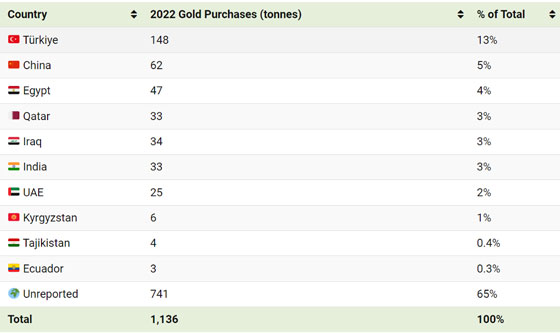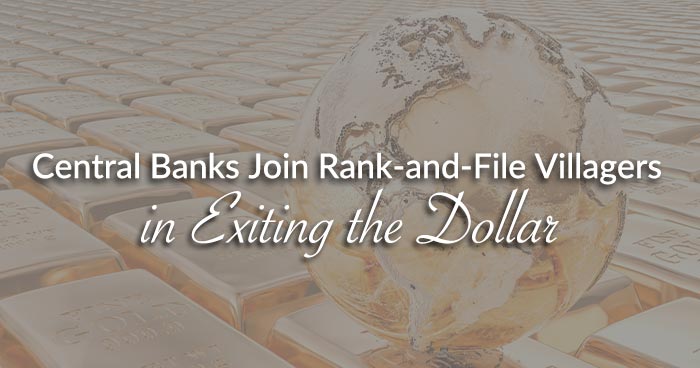Let's look around. With 99.9% certainty, I am confident that I have never witnessed a better setup for gold in my 40-plus years in business and reporting on natural resources.
First, I can show you that all fiat currencies eventually go to zero, but I will do that in another article.
As Voltaire said, "Paper money always returns to its intrinsic value – zero."
In other words, paper money is only worth something because people believe it is worth something, but when that belief erodes or disappears altogether, the money becomes worthless.
Today you can take this wisdom as a warning against the dangers of inflation, which erodes the value of paper money over time and can inflict sudden and catastrophic loss of value.
I can also show you how fractional reserve banking and our monetary policy have fueled a 70% revolt against the dollar. When I say 70%, I mean that 70% of the globe's citizens, through international transactions and now central banks, are planning various forms of exiting the U.S. reserve currency position.
Why Are Banks Hoarding Gold?
First, let's look at 2021, a record gold-buying year.
According to the World Gold Council, central banks bought 647 tonnes of gold in 2021. This was 29% higher than the previous year and the second-highest annual net purchases on record.
Several central banks increased their gold reserves significantly in 2021, with the most significant purchases made by Hungary, India, and Thailand.
The trend of central banks buying gold has been increasing in recent years as they look to diversify their reserves away from the Federal Reserve note dollar and other currencies.
In 2022, in addition to the biggies (China, Russia, India) now add Singapore, Turkey, Egypt, Qatar, Iraq, Hungary, and Poland plus just too many to list.
Central banks bought 1,136 tonnes of gold in 2022 — a whopping 25% leap on top of a 29% jump the previous year.
That's the most significant gold-buying jump by central banks since such records have been kept.

Why Are Central Banks in a Gold-Buying Frenzy?
The U.S. government's increasing debt levels have jeopardized the dollar's status as a world reserve currency.
The Federal Reserve's mismanagement of monetary policy (especially since launching Quantitative Easing in 2008) and failure to bring inflation rates down to target despite recent rate hikes signal that there is big trouble with the world's #1 superpower.
We discussed above why central banks are gobbling up gold and exiting the dollar. Now the villagers are also increasingly fleeing the dollar.
Today's banking crisis is directly related to the fact that debts are growing faster than the economy can pay.
When the Federal Reserve finally began raising the interest rates, this caused a massive problem for the banks. When interest rates increase, the market prices of bonds and mortgages fall.
Because of the Fed's frantic rate-raising pace, a significant arbitrage opportunity emerged, and people jumped all over it.
Banks only pay depositors about 0.3% on deposits.
Depositors began withdrawing their money from banks to buy U.S. Treasury bills paying as much as 5%, creating bank runs.
Bank runs have also helped spark a run into physical precious metals among savvy investors who realize that even higher-yielding paper instruments remain vulnerable to inflation and possibly even default.
Gold was trading around $300/oz. in 2000, and today it's over $2,000 (up 7x).
The global financial system is fragile and could collapse at any time due to excessive debt, derivatives, and artificially low interest rates followed by the insane pace of recent hikes in a short period.
Gold is becoming a sought-after store of value in a world where fiat currencies are no longer trusted.
If you don't buy gold and silver now, well... you have been warned.

About the Author:
Jon Forrest Little graduated from the University of New Mexico and attended Georgetown University's Institute for Comparative Political and Economic Systems. Jon began his career in the mining industry and now publishes "The PickAxe" which covers topics surrounding precious metals, energy, history, and politics.





